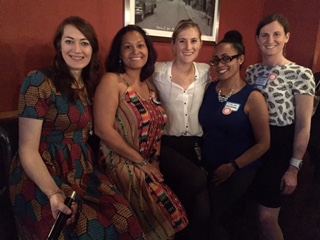At a panel focused on career changers, a question was posed to the crowd.
“How many people knew what they wanted to do their freshman year of college?” Several hands went up. “How many people are still doing what they said they wanted to do?” All hands went down except one. The crowd laughed.
It’s not a rarity in 2017 to change careers several times, but breaking into the tech world can be daunting.
The four panelists: Kristen Gallagher, UX specialist at Elsevier; Amy Cliett, national outreach manager at TechGirlz; Laura Oxenfeld, UX and business analyst at Delphic Digital and Michelle Colón, web developer at PHMC, assured the crowd assembled by Meghan Kelly of Girl Develop It at Ladder 15 on Monday that this career change is possible. The event was part of Philly Tech Week 2017 presented by Comcast.
Although each panelist took a different path to transition into tech, they left the audience with four main takeaways.
1. Imposter syndrome is OK.
Cliett recalled knowing that she had to make a change in May of 2014, after several years in corporate operations management. “I quit my job and became a full-time learner – like it was my job,” Cliett said. At her first major tech event, a hackathon, Cliett was scared to go but quickly realized she knew far more than she thought she did. Today Cliett is Techgirlz’s national outreach manager.
Gallagher previously worked as an addiction and mental health counselor. She said when she discovered coding, she realized she could create something that could help a lot of people. She honed her skills through Code Academy, Springboard and Girl Develop It. She says it’s normal to have imposter syndrome. “I wondered, should I even try coding?” she shared. Now, she says her social work skills are an asset in UX designing nursing education software because she can truly empathize with the customer experience.
2. Find your squad.
“Don’t be scared to reach out and talk to people,” Colón said. “Find your squad.”
“There’s only so many times a mother of four can start over and quit her job,” Cliett said. “There was a timeline I had to meet to start supporting myself when my savings ran out. Once I started venturing out and being part of a community, there were people I could talk to who could help problem-solve.”
“You need to find people who are further along in your journey than you, and you need to have a physical presence in the community,” said Oxenfeld, who wrote about her experience breaking into the tech scene earlier this year. She says volunteering and meeting up with different groups has made all the difference in her journey. “I would have given up if I didn’t have this community.”
3. Do the thing that scares you.
Colón previously worked in human resources. She knew she loved web design but never thought it could translate to a career. To start her career transition, she signed up for every class Girl Develop It offered, regardless of whether she understood exactly what she was signing up for. “I was super scared but I did it anyway. If you’re afraid of bugs, get a bug,” she told the crowd. “Do the thing that scares you. If you don’t ask or put yourself out there, the answer is always ‘no.’”
“I learned how to code, and then realized I needed to find clients,” said Cliett. “I went into coffee shops and pulled business cards off the wall that didn’t have websites and would contact people that way.”
Kelly, panel moderator and a fellow career changer, used to work in higher education. “I was terrified to come to Girl Develop It meetups by myself, but I did it. Now I want people to know they are welcome here. You’re all welcome here.”
4. There’s not just one path.
“There’s no syllabus for breaking into tech,” Oxenfeld said. Oxenfeld was planning on getting her Ph.D. in social science. Her master’s thesis focused on the culture of tech integration. Suddenly, it hit her. “People in technology learn all the time, create, write about it, etc. The stuff I liked in academics I could do in tech.” Once Oxenfeld discovered she wanted to make the change, she had no idea where to start. “The sheer amount of resources online is overwhelming,” she says. She said accepting jobs that felt like sidetracking at the time such as sales and support and volunteering for organizations like Philly CHI have helped her get to where she is today. “I started my transition three years ago and I’m still in it,” she said. “It’s a lot of work but it’s work that I love so it’s worth it.”
“A big challenge for me was finding the route,” Gallagher added. “You don’t really know where to start. One option of course is starting the transition while you already have a job on the side.”
On getting the confidence you need to make the transition? “It’s like my good friend RuPaul says,” Colón humorously offered to the audience, “if you don’t love yourself, how is somebody else gonna? You are the prize at the end of the day, and people would be happy to work with you.”
Here’s a list of resources mentioned by panelists:







